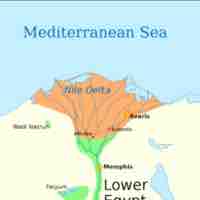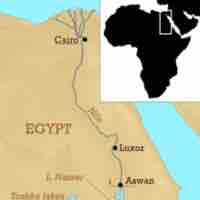Chapter 4
Ancient Egypt
By Boundless
The Old Kingdom, spanning the Third to Sixth Dynasties of Egypt (2686-2181 BCE), saw the prolific construction of pyramids, but declined due to civil instability, resource shortages, and a drop in precipitation.
The First Intermediate Period, the Seventh to Eleventh dynasties, spanned approximately one hundred years (2181-2055 BCE), and was characterized by political instability and conflict between the Heracleopolitan and Theban Kings.
The Middle Kingdom was a period of Egyptian history spanning the Eleventh through Twelfth Dynasty (2000-1700 BCE), when centralized power consolidated a unified Egypt.

The Second Intermediate Period (c. 1650-1550 BCE) spanned the Fourteenth to Seventeenth Dynasties, and was a period in which decentralized rule split Egypt between the Theban-based Seventeenth Dynasty in Upper Egypt and the Sixteenth Dynasty under the Hyksos in the north.
The New Kingdom of Egypt spanned the Eighteenth to Twentieth Dynasties (c. 1550-1077 BCE), and was Egypt's most prosperous time. It was ruled by pharaohs Hatshepsut, Thutmose III, Akhenaten, Tutankhamun and Ramesses II.
Hatshepsut ruled Egypt in the Eighteenth Dynasty (1478-1458 BCE), and brought wealth and a focus on large building projects. She was one of just a handful of female rulers.
The Third Intermediate Period (c. 1069-664 BCE) spanned the Twenty-first to Twenty-sixth Dynasties, and was marked by internal divisions within Egypt, as well as conquest and rule by foreigners.
Ancient Egypt went through a series of occupations and suffered a slow decline over a long period of time. First occupied by the Assyrians, then the Persians, and later the Macedonians and Romans, Egyptians would never again reach the glorious heights of self-rule they achieved during previous periods.
Ancient Egyptian religion lasted for more than 3,000 years, and consisted of a complex polytheism. The pharaoh's role was to sustain the gods in order to maintain order in the universe.
Ancient Egyptian art included painting, sculpture, pottery, glass work, and architecture. Many surviving art is related to tombs and monuments. Aside from the brief Amarna period, Egyptian art remained relatively unchanged for thousands of years.
Ancient Egyptian monuments included pyramids, sphinxes, and temples. These buildings and statues required careful planning and resources, and showed the influence Egyptian religion had on the state and its people.
Ancient Egyptians traded with their African and Mediterranean neighbors to obtain goods, such as cedar, lapis lazuli, gold, ivory, and more. They exported goods, such as papyrus, linen, and finished objects using a variety of land and maritime trading routes.
The Middle Kingdom was a golden age for ancient Egypt, when arts, religion, and literature flourished. Two major innovations of the time were block statues and new forms of literature.
